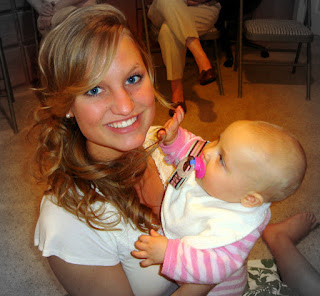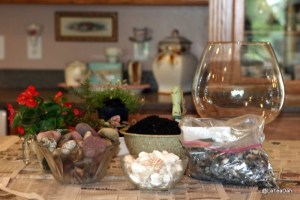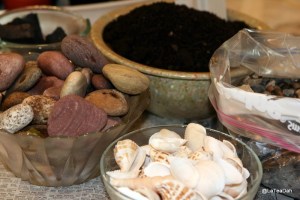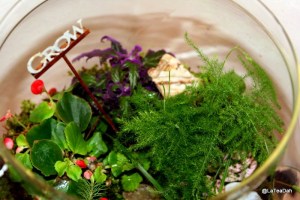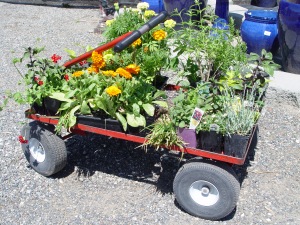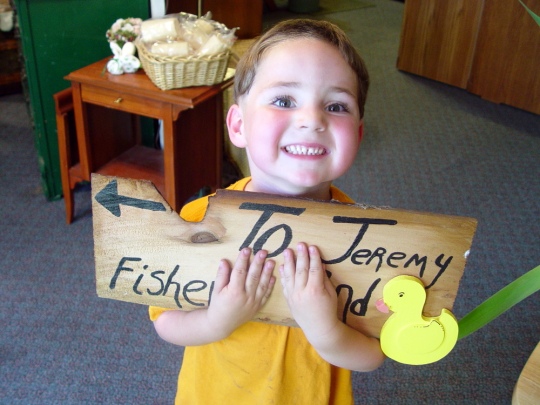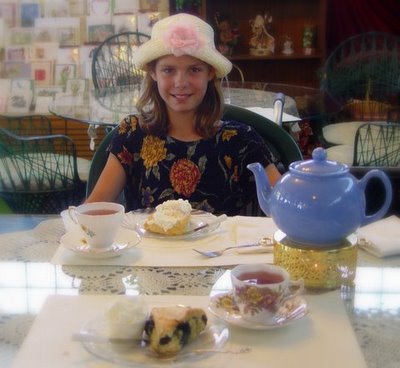Thursday, March 31, 2011
Sing & Memorize
Do your children like to sing? It's likely that they prefer singing to sitting down and memorizing something. But, have you noticed how easy it is to learn facts and verses if they are learned to music? In our homeschool, the children learned everything from math facts to the continents through song.
Recently I came across a helpful resource online for teaching children scripture to song. There are more than 300 original songs, written by Wayne Hooper of the Voice of Prophecy television ministry. This site offers free music to download as an aid to memorizing scripture songs.
It sounds like a winning situation all the way around to me! I hope they benefit you and your homeschool. Happy learning is always a welcome treat!
Wednesday, March 30, 2011
The Soul of a Child
The soul of a child is the loveliest flower
That grows in the garden of God.
Its climb is from weakness to knowledge and power,
To the sky from the clay to the cloud.
To beauty and sweetness it grows under care,
Neglected, 'tis ragged and wild.
'Tis a plant that is tender, but wondrously rare,
The sweet, wistful soul of a child.
Be tender, O gardener, and give it its share
Of moisture, of warmth and of light,
And let it not lack for the painstaking care
To protect it from frost and from blight.
A glad day will come when its bloom shall unfold.
It will seem that an angel has smiled.
Reflecting a beauty and sweetness untold
In the sensitive soul of a child.
Author Unknown
That grows in the garden of God.
Its climb is from weakness to knowledge and power,
To the sky from the clay to the cloud.
To beauty and sweetness it grows under care,
Neglected, 'tis ragged and wild.
'Tis a plant that is tender, but wondrously rare,
The sweet, wistful soul of a child.
Be tender, O gardener, and give it its share
Of moisture, of warmth and of light,
And let it not lack for the painstaking care
To protect it from frost and from blight.
A glad day will come when its bloom shall unfold.
It will seem that an angel has smiled.
Reflecting a beauty and sweetness untold
In the sensitive soul of a child.
Author Unknown
Labels:
character development,
children,
nature,
parenting,
soul
Monday, March 28, 2011
Peanut-butterfly
We all know that nutrition has a clear relationship to brain function. Fruits and vegetables are filled with antioxidants, vitamins, and minerals, all which help create healthy children. Sometimes it is a challenge to get children to eat enough of these healthy foods, but finding fun ways to entice children to munch on them can be a rewarding process.
A recent post in our local newspaper shared instructions called "Play with Your Food: Peanut-butterfly". Can you see what they did? Carrot sticks make the body of the butterfly. Apple wedges are sandwiched together with peanut butter in between, and then sliced in half so they can be formed and shaped make the wings.
Displayed on a pretty plate, it makes a pretty little lunch treat for your favorite kids! What other creative ideas have you tried to make healthy foods attractive to kids?
A recent post in our local newspaper shared instructions called "Play with Your Food: Peanut-butterfly". Can you see what they did? Carrot sticks make the body of the butterfly. Apple wedges are sandwiched together with peanut butter in between, and then sliced in half so they can be formed and shaped make the wings.
Displayed on a pretty plate, it makes a pretty little lunch treat for your favorite kids! What other creative ideas have you tried to make healthy foods attractive to kids?
Sunday, March 27, 2011
Summary: Lessons in Decision Making
Lessons in Decision Making: In the past nine posts, lessons for presenting the principles of decision making have been shared. This is a summary of those lessons with links to each one. Hopefully this summarizing post can assist you in presenting these principles and skills to your children.
Time spent in discussion and practice between parent and child is important as these precepts are taught.
Lesson 1: Lessons in Decision Making
Lesson2: Learning about Decisions
Lesson 3: What is My Will?
Lesson 3B: A Character Development Story: I'll Do it Later
Lesson 4: Determination and Decision Making
Lesson 5: My Conscience
Lesson 6: Reason's Role in Decision Making
Lesson 7: The Three Questions of Decision Making
Lesson 8: Keeping Moods and Feelings in their Proper Place
Lesson 9: Dealing with Peer Pressure
Labels:
character development,
decision making,
lessons,
unit study
Keeping Moods and Feelings in their Proper Place
Keeping Moods and Feeling in their Proper Place
Part 8
Learning the process of decision making is a valuable part of character development. Right decisions put us on the road to a happy and productive life. Wrong decisions hinder our process in growing into productive citizens and becoming individuals with integrity.
We have learned that there are three aspects to decision making. CONSCIENCE is my understanding of RIGHT and WRONG. We have learned that it must be trained. This happens through the teaching of wise parents and role models and by God's HOLY BIBLE. WILL is the part of me that DECIDES "I will" or "I will not". Sometimes WILL is called HEART'S DESIRE. And my REASON asks "What are the facts?" and "Would it make good sense to do it?".
There is another factor that people sometimes use to make decisions, but this factor really should not be considered. Unfortunately, some people use this as their main reason for making a decision and they ignore the WILL, REASON, and CONSCIENCE. Our feelings must be kept on the sidelines or they can really get in the way and keep us from making wise decisions. Have you heard the saying that FEELINGS are FICKLE? FEELINGS are a part of who we are. God created us with FEELINGS, but He didn't intend that FEELINGS control how we make decisions. FEELINGS serve other purposes in our lives.
Your FEELINGS and MOODS are your REACTIONS to things and people around you. Decisions should never be based upon REACTIONS. Some FEELINGS you may have are happy, sad, angry, grumpy, extravagant, lazy, and so on. It is important to ask yourself these questions:
Do my moods and feelings control me?
Am I a slave to my moods and feelings or am I free?
Use the questions below to help you determine if you use your moods as an excuse for your behavior. In each situation, tell which mood is being given attention (happy, sad, angry, grumpy, extravagant, lazy).
1) I know I can't really afford it, but I just had to have it!
2) It's no use (sniff) because things will really never get any better (sob, sigh).
3) I will teach you! (WHAM!)
4) I was so mad at him, I hit him without thinking.
5) No, you can't make me. I don't want to. That won't help. Leave me alone. Go away.
6) I know it needs to be done, but I'm just not in the mood to do anything. Maybe tomorrow.
What other feelings or moods can you think of that can be added to the list?
Can you think of any feelings or moods that might not get in the way of making a wise decision? (There are two: happy moody and cheerful moody). Why do you think these two would not get in the way?
Labels:
character development,
decision making,
emotions
Dealing with Peer Pressure
Dealing with Peer Pressure
Part 9
Even though we can learn how to make wise decisions and choose to do the right thing, sometimes PEER PRESSURE gets in the way. Our friends may suggest that we do things or go places that we may decide are not right. It can be hard to tell a friend NO. Sometimes children and teens even ask their parents to please "say I cannot go there" or "do a specific thing" because it is easier to have a person in authority back them up in their decision. But, there are some tools that can be learned that can help children and teens as they deal with PEER PRESSURE.
By practicing the technique offered in this tool, support can be gained in making dealing with friends who don't want to do the right thing.
Here is an example:
- Friend: Hey, let's go back behind the church during prayer meeting. I have a cigarette that I got from Mark and we can see what it is like to smoke.
- You: No, that's against my parents rules and it is bad for our health. If I went with you and we got caught, my parents would ground me for a long time! They might even say that we cannot be friends any more. And it would be bad for our lungs.
- You: Instead, why don't we see if Mr. Jones needs help operating the video equipment tonight during prayer meeting. Maybe he will let us do the actual filming tonight.
- Friend: I'd rather go behind the church and smoke.
- You: I'm going into the church to talk to Mr. Jones. If you change your mind, I will be there and will let you help me run the video camera. I hope to see you there.
When a friend suggests doing something that you don't feel is right, these are the steps.
1) Name the trouble.
No, I don't want to do that because it is (illegal, theft, vandalism, against family rules, possession by a minor, assault, unkind to others, etc).
By naming the trouble, you are expressing the bottom line or the nitty-gritty of the situation. You are making it real.
2) Name the Consequences
If we got caught we could (get a fine, be kicked of the soccer team, be arrested, have our driver's licenses taken away, etc.)
By naming the consequences you are using alerting your friend to the seriousness of the situation. You are helping him/her see what could happen if you get caught.
3) Present an Alternative
What could you do instead of the "trouble"? Think of things that your friend(s) might like to do instead of what they are offering (go roller skating, visit Susan and play a game with her, ride our bikes to the top of the canyon road and back, take my video camera and film one another jumping dirt piles with our bikes, play kick ball, etc.).
4) Act upon your decision and give your friend an "out" to make the right choice as well.
Tell them that you are choosing the alternative to the trouble they have named. Allow them the freedom to make their own choices, but suggest alternatives and give them the opportunity to do the right thing.
Remember to:
Name the Trouble
Name the Consequences
Present an Alternative
Offer the Friend an Out
SPEND TIME with your parent(s) or with friends, practicing the "trouble-consequence-alternative" technique. Take turns thinking of "trouble" and then think up "consequences" and "alternatives". Practice so much that this process becomes easy and instant for you! When it does, you will feel much more confident in responding when your friend(s) suggest trouble.
Remember that sometimes it is wise for you to talk to your mom or dad about what happened. They can help to reaffirm your choice(s) and may have suggestions for helping your friend make right choices too. When illegal activities are chosen by your friend, your parent may feel it best to talk to your friends parents or to authorities.
The Three Questions of Decision Making
The Three Questions of Decision Making
Part 7
There are three questions to ask before making a decision. They are:
1) Do I have all the facts? [Reason]
2) Is it right? [Conscience]
3) Do I really want it? [Will]
By remembering to ask these three simple questions, we can make wiser decisions. If you can ask YES to each question, you know that you are making the right decision. But if the answer to any of these questions is NO, then the wisest answer is probably no.
Sometimes WILL is called HEART'S DESIRE. It might be easier to remember the steps in the decision making process if you associate those words with your decision making process.
With your student, spend some time thinking of decisions that children (or teens) make on a frequent basis. Start by making a list of decisions. Then, together go through the decision making process using the questions above. Remind the student that if there is a conflict, then the decision response should be NO. Discuss why.
Here are some decision making situations to help you and your child get started:
1) Buy the new computer game that all my friends are talking about.
2) Wait to feed my pets until afternoon.
3) Talk back to my piano teacher because I think she is too strict about how long I need to practice.
Continue practicing until you are confident that your child/teen has a clear understanding of how to apply these principles. Review daily if necessary.
Remember, CONFLICT between the three questions related to REASON, CONSCIENCE, and WILL/HEART'S DESIRE is a RED FLAG in the decision making process. CONSENSUS is necessary when making a decision that is wise.
https://www.onlythebible.com/Bible-Gems/King-Will-and-three-judges.html
Labels:
character development,
conscience,
decision making,
reason,
will
Friday, March 25, 2011
Reason's Role in Decision Making
Reason's Role in Decision Making
Lesson 6
Throughout these lessons, we have learned that teaching children about decision making is a process. Helping them learn the steps in making good decision assists them in the process of making wise decisions throughout their lifetime. Having a decision making road map is a tool that valuable resource for them. Today's lesson teaches about the role that REASON has in decision making.
* * *
Talking Points:
My WILL has another helper called REASON. My REASON is the special gift that God gave to me so that I am able to THINK THINGS THROUGH before my WILL decides whether I WILL or I WILL NOT do something.
My REASON uses FACTS. It weighs EVIDENCE. It tries to put all the pieces together like a picture puzzle and to MAKE SENSE out of everything.
Your brain works in the same way to make wise decisions. Your WILL has a helper called REASON. REASON uses FACTS and weighs EVIDENCE. It is what helps you MAKE SENSE out of everything.
Here is an example of how it works:
FACT: I know that it isn't any fun at all to be sick or to have problems with my teeth.
FACT: Besides being uncomfortable, going to a doctor or dentist costs a lot of money. This money could be spent on other things like clothes, toys, or interesting books. If I take good care of my teeth that money could be spent on these things.
FACT: I know that eating lots of junk food can cause some serious problems with my general health, including my teeth.
FACT: I know that there are some snacks that taste good and are also good for me. God has created lots of different kinds of fruits, nuts, seeds, and vegetables that are delicious! They are much better for my health and teeth than junk food snacks.
My REASON weighs the evidence and then answers the question:
Does it MAKE SENSE to eat a lot of junk food just because it tastes good? This part of decision making relies upon the INTELLECT.
When DECISION MAKING, WILL and CONSCIENCE play a role along with REASON.
My CONSCIENCE tells me whether it thinks it would be RIGHT or WRONG.
Even with REASON and CONSCIENCE, my WILL is still free to decide I WILL or I WILL NOT eat the junk food. If WILL does not ignore REASON and CONSCIENCE it will make a good choice. But, WILL can ignore its two helpers and make poor choices.
God created every person with the freedom to make CHOICES about how they will live their lives. Do you like being so FREE? This God-given freedom allows each human being to decide what they will do when it comes to making any decision.
Doesn't it make sense to keep WILL, CONSCIENCE, and REASON together in agreement?
Labels:
character development,
conscience,
decision making,
reason,
will
My Conscience
My Conscience
Lesson 5
We have been studying about the "will". We have learned what it is and what it does. To review, let's read the following statements and decide if they are true or false.
My WILL is:
1) something I need to understand (and it is quite simple to comprehend)
2) not really important for me to understand
3) something that is very difficult for any young person to understand
4) something I have no control over
5) my wish, even a tiny one, because my smallest wish can grow into whale size determination if I spend enough time wishing, hoping, dreaming, wanting, or even praying for it, as thinking about it feeds it
6) my want, or my desire
7) my firm determination
8) the part of me that decides "I will" or "I will not"
Today we are going to learn about the HELPER that our WILL has. It helps us decide what we WILL do and what we WILL NOT do.
This helper is called our CONSCIENCE.
Our verse for this lesson is: Thy word have I hid in my heart, that I might not sin against thee. Psalm 119:1
By studying the WHOLE Bible we experience the safest way to train our conscience.
My CONSCIENCE is what I THINK is right and wrong. It is my UNDERSTANDING of good and evil. A person's CONSCIENCE must be TRAINED to tell the difference between what is right and what is wrong. Someone must TEACH it about good and evil.
Which of these people or things can teach you and train YOUR CONSCIENCE? Discuss your answers with your parent(s). Explain your answers. Remember, some of these people or things are reliable and trustworthy. There are others that we must be careful about what we learn from them. Discernment must be used.
1) my mother
2) my father
3) my older brothers or sisters
4) the radio station I select
5) the books I read
6) the television programs I watch
7) the stories I read in magazines
8) the pictures I choose to see
9) the games I like to play
10) my grandparents
11) my aunts and uncles
12) my babysitter
13) my pastor
14) the friends I choose
15) people I admire
16) my Bible
17) my favorite daydreams
All of these people or things can teach you the truth about what is right or wrong. But, it is important to realize that you must be careful who and what you trust to do this important job. Thankfully, God will never fail you and His word, the Bible, is trustworthy.
In your own words, tell what CONSCIENCE is and tell HOW you develop it.
Labels:
character development,
conscience,
decision making
Determination & Decision Making
Determination & Decision Making
Part 4
Discussion starter: Think about any recent decisions you have made. Recall how you fed (or starved) your "wish fish". Talk about the wisdom or foolishness of your choice to feed (or starve) this particular wish fish. What were the advantages and/or consequences of your decision. Talk about what might have been if you had not fed (or starved) your fish. Children and teacher-parent can each share the answers to these questions and talk about the choices that were made.
Lesson Review: We have learned about our "will" and that it is the part of us that decides things. We choose "I will" or "I will not". Our determination do or have something usually starts with a wish that grows when we feed it by spending time thinking about it. We want to FEED the good little "wish fish" so that they will grow into a DETERMINATION to do right. But we want to STARVE the "wish fish" that could grow up into dangerous desires.
Let's learn more about how we feed or starve these wish fish. In each situation below, tell if the "wish fish" is being FED or STARVED.
1) think about it all the time
2) daydream about it
3) keep our minds busy thinking about a better kind of fish
4) pray for it
5) spend time wishing and hoping for it
6) talk about something else with our friends
7) crowd it out of our minds
8) read books about it
9) concentrate on something good instead
What kind of person do you want to be? Have you spent time thinking about it? How do you want to act? In each situation below, choose the word or words that DESCRIBE your DETERMINATION. Talk about your answers.
A) I will/will not play fair.
Talking points: Name some benefits of playing fair. Name some disadvantages of cheating. Are there any disadvantages to playing fair? Are there any real advantages to cheating?
B) I will/will not sulk and pout.
Talking points: Do you admire someone who sulks and pouts when they don't get everything they want?
C) I will/will not care for my pets.
Talking points: Can you learn anything from caring for your pets? What specifically?
D) I will/will not respect authority.
Talking points: Who does this mean for a one-year-old? Who does this mean for you? Who can you add to the one-year-old's list? Is this evidence that you are growing up? Is there anyone on your parents' list that is not on your list yet?
Key words: parents, grandparents, teachers, police, babysitter, employer
E) I will/will not do my chores cheerfully.
Talking points: Have you ever done your chores cheerfully? Have you ever grumbled your way through them? Which way is best for you? Why?
F) I will/will not try to get even.
Talking points: Can you ever REALLY "get even"? How? What price might you pay if you TRY to "get even"?
Key scripture helps (click on link): Exodus 21:23 - 25 * Matthew 5:39 * Luke 6:29 * Leviticus 19:18 * Romans 12:19 - 20
Continue your discussion in the same manner as you did for the previous key points.
G) I will/will not forgive you.
H) I will/will not say "NO!" to drugs.
I) I will/will not take God's advice.
J) I will/will not share with you.
K) I will/will not stir up trouble.
L) I will/will not cheat so I can win.
M) I will/will not remind you of your past mistakes.
N) I will/will not help you.
O.) I will/will not make fun of others.
P.) I will/will not hurt God's animals.
Q.) I will/will not take foolish dares.
Something to think about: The choices we make determine who we are. Describe a person that you think would make a good neighbor. Ask yourself if YOU are the kind of person that angels would be glad to see move into the house next door.
A Character Development Story: I'll Do it Later
Lesson 3B
Aunt Carol reads a chapter from a good book. The chapter is called "I'll Do it Later". If you'd like to hear it, click here. After listening to the story, discuss how Becky did or did not use her "will" in her decision making progress.
Aunt Carol reads a chapter from a good book. The chapter is called "I'll Do it Later". If you'd like to hear it, click here. After listening to the story, discuss how Becky did or did not use her "will" in her decision making progress.
Thursday, March 24, 2011
What is My Will?
What is My Will?
Part 3
The will has a very strong influence upon any decision that a person makes. Your will is your WISH, your DESIRE, what you WANT, your DETERMINATION. Think of it as a very tiny fish. Think about feeding that tiny fish and spending time with it. After awhile, the tiny "wish" fish becomes a bigger and bigger "want" fish. If you keep on feeding it by thinking about it more and more, eventually it will become a WHALE size DETERMINATION! So, it is important that we choose carefully about which "wish fish" we feed and which ones we choose to leave alone. Even the smallest "wish fish" can grow into whale size determination. It is very important for us to realize which wish fish are safe to feed and which ones could grow up into dangerous desires.
Here are some questions to think about. What makes a wish grow into a want, and finally into determination? In other words, what does the fish food represent?
Some of our "wish" fish need to be fed. For example: "Mom looks so tired. I wish I could help her." What other "wish" fish thoughts can you think of that should be fed?
Some of our "wish" fish need to be starved! For example: "I wish I could get even! I am so mad and I'd surely like to show them who's best!" What other examples of "wish" fish can you think of that should be starved?
In the Bible, there are stories about people who showed great determination to do right. Daniel and his three friends are a good example of young people who used their "will" to make right choices. Instead of choosing the unhealthy food that the king provided, they asked for fruits, vegetables, grains, and legumes. To the royal court, these were considered plain food, more fit for paupers than anyone in the king's household. But Daniel and his friends used their wills to help them stay strong and make choices according to what they believed was right. They ended up being healthier and stronger than all the other young men in the king's care. Their superior health and performance was a natural result or consequence of taking care of their bodies by good nutrition, rest, exercise, water, and sunshine. They discovered that by following God's natural laws they reaped great benefits because God's laws make sense. This experience helped them to realize that God doesn't say things like "you better take care of your bodies or I will be angry with you". Instead they learned that God says things like "please take care of your bodies, or they won't work as well for you as they could." God doesn't impose His will on us, forcing it to become our will. Instead, he loves us and gently shows us the best way. He gives us the power of choice. We can use our will in any way we choose. But by making wise decisions about how we will use our will, we can reap results as good as those experienced by Daniel and his three friends.
There are other stories that you can read about in the Bible that show of WHALE SIZE determination to do right! You can read some of these stories here (click on link):
The Fiery Furnace
The Lion's Den
Good Kings Joash and Josiah
In Psalm 40:8 it says "I delight to do thy will, O my God. . .your law is within my heart." Why will I enjoy following God's advice for me? The "law in my heart" means that I agree with God. In the highest sense of freedom available to anyone, I choose to do what He asks because I understand that it is the best for me. It makes sense to do it. Why would I want to choose any other way?
The Bible also says, in Philippians 4:8, that "Whatsoever things are true and honorable and right. . .think of things." This verse of scripture is suggesting some good "wish fish" that we should feed. How can this verse help you decide which are the good fish that are safe to feed?
My WILL is the part of me that DECIDES "I will" or "I will not". Our determination to do or have something usually starts with a wish that grows when we feed it by spending time thinking about it.
In or next lesson we will learn about determination.
Labels:
character development,
choices,
decision making,
will
Learning about Decisions
Learning about Decisions
Part 2
Lesson for children:
What decisions have YOU made today?
Do you think that any of them were important?
Were some of them easy choices?
Were any of them difficult to make? Which ones?
Why are some decisions more difficult to make than others?
All of us make decisions every day. We decide when to get up, what to wear, what to eat, where to go, what to do, and how we will respond to the words and actions of others.
Some decisions may affect us for no more than a few seconds or minutes. The consequences of other choices may be felt for the rest of our lives. Often the decisions we make have an impact upon the lives of others too.
If we will take the time to discover how to make better choices and wiser decisions, we can enjoy more satisfying lives. By making wiser choices we can be better people. Those around us who share the consequences of our decisions may also benefit greatly.
In the future, will be spending some time learning about how decisions are made. You will get to know your WILL, your REASON, your CONSCIENCE, and your MOODS. You will discover how they all interact when you make decisions. And you will learn which ones sometimes get in the way of making the wisest choices.
Let's go through a list of decisions that you make during your lifetime and talk about them. Then let's decide these things:
1) Which decisions would affect you for just a few seconds or minutes?
2) Which ones could have lifetime consequences? What are they?
3) Which ones could affect the lives of other people too? In what ways?
Here's the list of decisions we will be talking about:
A) to buckle your seat belt or not
B) to spend all your money or to save some
C) to play fair or to cheat
D) to eat nutritious food or junk food
E) to take care of your things or to neglect them
F) to do your best or to do only enough to get by
G) to put yourself first or to consider the rights of others
H) to watch lots of TV or to read and play active games
I) to do your share or to leave the job for someone else
J) to experiment with harmful substances like alcohol, drugs, and tobacco or to leave them alone
K) to pick friends who are a positive influence or to choose friends who are wild and don't follow the rules
L) to do your homework or to think of only having fun
M) to make fun of others or to consider their feelings
By examining how you answered these questions, analyze yourself and decide if you make wise or sad choices. Discuss how you perceive your ability to make wise decisions with your mom or dad.
Labels:
character development,
choices,
conscience,
decision making,
reason,
will
Wednesday, March 23, 2011
Lessons in Decision Making
Lessons in Decision Making
Part 1
Teaching children about decision making is a process that can be challenging, yet rewarding as we see them learn to make wise choices about the things in their lives that affect them. You can introduce this subject by asking them a few questions that will open their minds for discussion. They are:
1) What decisions have you made today? Can you tell what they were?
2) Do you think that any of them were important decisions? Why or why not?
3) Were some of them easy choices? Difficult ones? What made them easy or hard?
By creating a list of possible decisions that your child might make, discussion is facilitated and they can help decide how a response can have effects that can make a difference. Here are some examples:
Decision: to by a yellow balloon or a purple one
Does the answer to this decision have a consequence that can last a short time? or a lifetime?
Who is affected? Me, others, or both?
Decision: to wear a blue sweater or a green one
Does the answer to this decision have a consequence that can last a short time? or a lifetime?
Who is affected? Me, others, or both?
Decision: to drive my bike (or car) recklessly or carefully
Does the answer to this decision have a consequence that can last a short time? or a lifetime?
Who is affected? Me, others, or both?
By responding to these questions, children can determine that some choices in the decision making process are more important than others. Take this time to talk with your children about some of the specific decisions they have made recently. Then, have them think of at least one specific example for each of the decision making processes below:
1) a slow, thoughtful, deliberate decision
Example: Sally took an hour looking at every Father's Day card in two stores before deciding which one was exactly right for her special Dad.
2) a snap decision, made with almost no thought at all
Example: Luke accidentally bumped into Mark on the playground during recess and knocked him down. Instantly Mark was shouting angry insults at Luke. Then he deliberately pushed Luke backwards so that he fell to the ground.
3) a default decision made simply by remaining undecided until it is too late to act
Example: Linda couldn't decide whether she wanted to get dressed up to go shopping with Mother or go with Julie's family to the park across town. She was undecided for so long that Julie's family left without her and it was too late for her to get dressed up to go with Mother. She had to stay home with her younger brother and a babysitter.
Discussion points: Explore the differences between natural consequences and imposed penalties. Sometimes parents protect very young children from dangerous natural consequences by threats of less severe imposed penalty simply because children can understand them better. For example, a child might not understand the dire consequences of running into the path of an oncoming car, but they might understand and respect an imposed penalty like having a privilege taken away.
God has children of all ages, and the Bible speaks to us all. Sometimes God threatens us with punishment, but He wants us to grow up enough to understand the reasons behind His advice. His rules are to protect us from dangerous natural consequences. His advice makes good sense if we will just look for the evidence. God wants us to obey because we agree with Him, not because we are afraid of Him.
Saturday, March 19, 2011
Homeschooler Raises Exotic Birds
Natasha K. is a college student living near Orlando, Florida. She was affected by an illness during her childhood that prevented her from attending her local church school. As a result, she was homeschooled during her middle school and high school years. The local academy recommended that she enroll in a high school program for homeschoolers, and she completed all requirements for graduation in three years instead of the usual four. She says she had wonderful teachers and it was a positive experience for her, although she admits that learning a foreign language with only a textbook was challenging. Today I am sharing an interview with Natasha in which she tells about her love for nature and how her appreciation for God’s creatures has helped her become an expert in raising exotic birds.

Tasha, having known you since infancy, I have always admired your innate interest in nature and the things that God made. Please tell us about that interest and how it was developed in your life.
I have always been very in tune to nature and all of the things God created. When I was little I would go up to any animal I could, whether that was a turtle, frog, goat, anything in the norm, and out of it too. I was never fearful of any animal that I happened across. While I was growing up, my family was very involved in nature activities. We would go on nature walks, visit farms, and zoos. We enjoyed all that God has created for us. It was something that my mother and my grandparents encouraged in me and helped me with. I remember when I was little I would cry when even a bug got killed. To this day, I still try to catch the bugs that make their way inside to release them back outside.

Is there one part of nature study that you have taken on as your specialty? What is it? How did it start?
I wouldn’t say I have one area of nature that is my specialty. I love everything to do with nature! However, I do try to help out any animals that need extra assistance. I have rescued cats, frogs, baby possums, birds, lizards, baby raccoons, and many more creatures. Some I have kept until they were ready to be released back into the wild and others I found a more suitable home for because they had extra issues they were dealing with. It’s almost like I have a calling card out there that says that any animal, stray or injured, knows where they can come to find help and a haven.
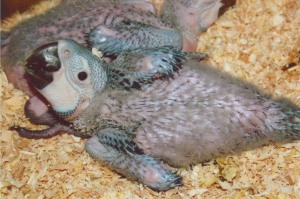
I know that you have worked extensively with exotic birds. Please tell us about your experience in raising them.
I started working at a bird store during my teen years. It seemed to be a perfect fit for me, because I got to be around animals all day long. I started out as just a grub worker, cleaning cages and doing the dirty work, which I never minded. I enjoyed making things better for the birds. In just doing that, I developed bonds with them. It wasn’t too long though, before the owner of the store saw this connection and wanted me to try working with the babies. At that point I started hand feeding and taking the babies who fed through the night home with me. At one point I had over 50 babies at my house, not to mention all the ones at the store as well. I had a connection with each and every one of them. I started working with the vet and ended up giving shots and helping with all of their other medical needs too, including sitting in and helping with surgeries. I have raised every kind of exotic bird, from parakeets all the way up to a hyacinth macaw (which is the largest of all exotic birds). In addition, I have raised many from the egg or just one day old up, because the parents refused to take care of them. In a sense I became mama bird to all of the babies.
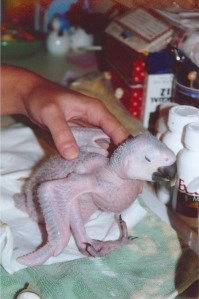
Raising each bird is unique, depending on the age and species of birds. Some of the main issues involved in raising and caring for baby birds are: making sure they have clean and dry bedding when they are really small and then clean cages when they are bigger; hourly feeding depending on the age; and giving each and everyone the tender loving care that makes an affectionate, loving and gentle bird. It is also important to make sure they stay clean, with no formula or waste on their skin or feathers. It’s important to keep an eye out for any changes that there might be in their behavior or health, as this could mean there is something wrong with them which might need to be addressed as soon as possible by a vet. There are many other details but those are the most important ones.
After the babies are finished being hand fed, they get new homes. Sometimes people come into the store and buy them before they are grown enough to leave, so the babies stay around until they are ready for their new homes. Hand feeding is a very precise thing and it could be deadly if done wrong. When I worked at the bird shop, I would try to make sure each potential owner knew about the behavior of each type of bird, as some are more energetic, others more loving, etc. This way the customer would know what they were committing to. Also I’d make sure they knew the life expectancy for the bird they were interested in, as some live almost 100 years. I wanted them to know it really was a lifetime commitment. Then I would make sure each potential owner had a connection with the bird they were interested in. If they didn’t have a connection, I tried to direct them to a different bird. It wouldn’t be a good relationship for the bird or owner if there wasn’t a connection. The main thing was to make sure they were going to be a loving person or family who would take really good care of each and everyone. Even though raising baby birds can be fun, it is a lot of work and takes a lot of commitment! There are also many abandoned and abused birds in the world who need loving and caring homes too.
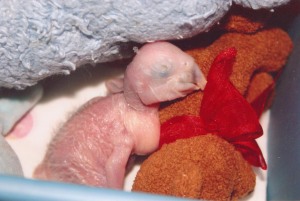
Please share with us where you are in life right now — and what your plans for your future are. Do you see that nature study will be a part of your future? How?
Right now I am going to college, trying my hardest to finish as quickly as I can. I am studying occupational therapy. Even though I am not perusing a career in nature, nature will always be a part of who I am as a person. I may no longer work in the bird store, but I still get calls for advice from them, customers, and even breeders. In addition I still have my own birds that I have adopted along the way.
Thank you, Tasha, for sharing about raising exotic birds and of the importance of nature study in the development of a well-rounded individual. Much success to you as you continue your education. It is always encouraging to hear from successful homeschooled students.

Tasha, having known you since infancy, I have always admired your innate interest in nature and the things that God made. Please tell us about that interest and how it was developed in your life.
I have always been very in tune to nature and all of the things God created. When I was little I would go up to any animal I could, whether that was a turtle, frog, goat, anything in the norm, and out of it too. I was never fearful of any animal that I happened across. While I was growing up, my family was very involved in nature activities. We would go on nature walks, visit farms, and zoos. We enjoyed all that God has created for us. It was something that my mother and my grandparents encouraged in me and helped me with. I remember when I was little I would cry when even a bug got killed. To this day, I still try to catch the bugs that make their way inside to release them back outside.

Is there one part of nature study that you have taken on as your specialty? What is it? How did it start?
I wouldn’t say I have one area of nature that is my specialty. I love everything to do with nature! However, I do try to help out any animals that need extra assistance. I have rescued cats, frogs, baby possums, birds, lizards, baby raccoons, and many more creatures. Some I have kept until they were ready to be released back into the wild and others I found a more suitable home for because they had extra issues they were dealing with. It’s almost like I have a calling card out there that says that any animal, stray or injured, knows where they can come to find help and a haven.

I know that you have worked extensively with exotic birds. Please tell us about your experience in raising them.
I started working at a bird store during my teen years. It seemed to be a perfect fit for me, because I got to be around animals all day long. I started out as just a grub worker, cleaning cages and doing the dirty work, which I never minded. I enjoyed making things better for the birds. In just doing that, I developed bonds with them. It wasn’t too long though, before the owner of the store saw this connection and wanted me to try working with the babies. At that point I started hand feeding and taking the babies who fed through the night home with me. At one point I had over 50 babies at my house, not to mention all the ones at the store as well. I had a connection with each and every one of them. I started working with the vet and ended up giving shots and helping with all of their other medical needs too, including sitting in and helping with surgeries. I have raised every kind of exotic bird, from parakeets all the way up to a hyacinth macaw (which is the largest of all exotic birds). In addition, I have raised many from the egg or just one day old up, because the parents refused to take care of them. In a sense I became mama bird to all of the babies.

Raising each bird is unique, depending on the age and species of birds. Some of the main issues involved in raising and caring for baby birds are: making sure they have clean and dry bedding when they are really small and then clean cages when they are bigger; hourly feeding depending on the age; and giving each and everyone the tender loving care that makes an affectionate, loving and gentle bird. It is also important to make sure they stay clean, with no formula or waste on their skin or feathers. It’s important to keep an eye out for any changes that there might be in their behavior or health, as this could mean there is something wrong with them which might need to be addressed as soon as possible by a vet. There are many other details but those are the most important ones.
After the babies are finished being hand fed, they get new homes. Sometimes people come into the store and buy them before they are grown enough to leave, so the babies stay around until they are ready for their new homes. Hand feeding is a very precise thing and it could be deadly if done wrong. When I worked at the bird shop, I would try to make sure each potential owner knew about the behavior of each type of bird, as some are more energetic, others more loving, etc. This way the customer would know what they were committing to. Also I’d make sure they knew the life expectancy for the bird they were interested in, as some live almost 100 years. I wanted them to know it really was a lifetime commitment. Then I would make sure each potential owner had a connection with the bird they were interested in. If they didn’t have a connection, I tried to direct them to a different bird. It wouldn’t be a good relationship for the bird or owner if there wasn’t a connection. The main thing was to make sure they were going to be a loving person or family who would take really good care of each and everyone. Even though raising baby birds can be fun, it is a lot of work and takes a lot of commitment! There are also many abandoned and abused birds in the world who need loving and caring homes too.

Please share with us where you are in life right now — and what your plans for your future are. Do you see that nature study will be a part of your future? How?
Right now I am going to college, trying my hardest to finish as quickly as I can. I am studying occupational therapy. Even though I am not perusing a career in nature, nature will always be a part of who I am as a person. I may no longer work in the bird store, but I still get calls for advice from them, customers, and even breeders. In addition I still have my own birds that I have adopted along the way.
Thank you, Tasha, for sharing about raising exotic birds and of the importance of nature study in the development of a well-rounded individual. Much success to you as you continue your education. It is always encouraging to hear from successful homeschooled students.
Hurt Not the Earth
In the beginning, God created the heavens and the earth. As we look at nature around us, we find much of beauty to enjoy and many lessons to be learned. Nature is a delightful place to center school subjects for children. Deserts, mountains, beaches, and tundra each provide homes for a variety of plants and animals. Habitats vary and each provides an opportunity for the homeschool family to explore nature and to learn how to care for Earth. Revelation 7:3 admonishes us “do not harm the land or the sea or the trees”, reminding us that God’s principles require us to care for the things He has created for us to enjoy.
Simply by looking out of a window, a home school family can observe many interesting things in nature. By looking out mine, I can see flocks of a dozen or more white pelicans as they glide through the air so gracefully. The Canadian geese are starting to gather on the wildlife refuge ponds next door, preparing for their annual migration. In the late afternoon they create a cacophony of noise Cute faced raccoons, adorable little pests, visit after darkness falls, stealing cat food from a bowl on the porch. Their eyes glow in the dark when you shine a flashlight at their faces! A few months ago a mother killdeer had a nest in the gravel at the edge of our lawn and seemed to flutter for miles with her fake broken wing when anyone came near. Hummingbirds at feeders, and tiny bats who live in eaves, provide enjoyment and lessons to those who observe.
Even from an armchair, nature’s antics provide much to behold. By going outside, even more senses are engaged as the fragrances, textures, sights, sounds, and tastes of nature are experienced. A mountain experience brings rewards and joys. Wild mushrooms, leaves of all sizes, shapes, and colors, and fragrant flowers entice children to pluck, smell, and feel them as they are discovered. Some things are safe to taste, like wild strawberries, astringent elderberries, and pine needles made into a fragrant tisane. Forest creatures, such as wild turkeys, mule deer, white-tailed deer, and elk are easily observed on a walk through the woods or meadow. Even this late in the year, the lush green of new growth shares its story of hope and the creation of all things new.
It’s interesting to observe how God speaks to us through His creation. And it is overwhelming when one realizes the breadth and width of human responsibility when it comes to caring for the natural world. Caring for Earth is a commission we need to take seriously. Teaching children about God’s care for us, and for His commission to take care of the plants, creatures, and terrains He created provides lessons in ecology, stewardship, and God’s protection and care. Together we can do our part to make our environment a safe and beautiful place. Hurt not the earth, neither the sea, nor the trees. A reminder to us all!
Labels:
creation,
ecology,
environment,
family excursions,
nature,
stewardship
Nature Naturally Inspires
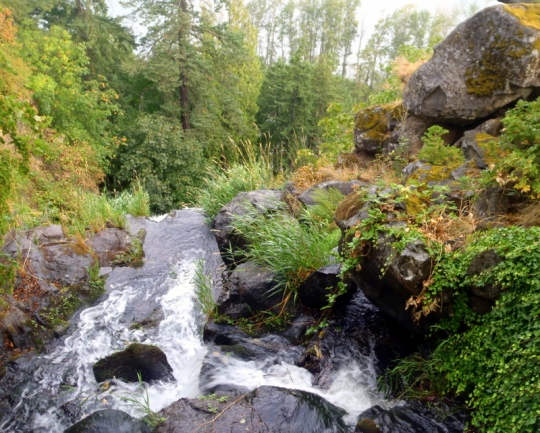
“It is in nature, among the things which God has created, designed and brought forth himself, that we are in the most natural atmosphere to be inspired. Creative ideas are apt to flow in the midst of the creativity expressed in God’s creation, as one is temporarily from the confusion of conflicting voices…”
This quote, by Edith Schaeffer in her book, The Hidden Art of Homemaking, expresses the value of nature study as a family activity. Her basic premise is that through experiences in nature, children develop creative skills that cross all educational parameters. Time spent in nature results in creative children! Nature stimulates creativity, refreshes one’s ideas, and stirs productivity. And it all simply ‘happens’ without specific energy and instruction on the part of the teaching-parent.
The best way to get out into nature is by using your own two feet! Nature study differs from recreation in the great outdoors. Motorboats, jet skis, ATV’s, and motorcycles might be great tools for exercise and recreation, but when it comes to studying the natural world, a good pair of walking shoes and ample energy are the best resources. Observation happens best during quiet times like a walk in the woods, a hike through the field, or barefoot on a sandy beach. Tools, like a walking stick, binoculars, magnifying glasses, a zip-lock bag to gather things in, a camera, and field guides can all work together to enhance observation. Studies and inside chores for long time-spans in the day can result in restless children. But, in nature even the tired become refreshed. Stress and fatigue dissipates and perspectives change. Time in nature heals weary hearts.
With gentle and quiet guidance, a teacher-parent can direct children to creative ventures that result from time spent in nature. Nature’s color schemes can be used to study the color wheel. Primary and secondary colors are all around in every type of landscape. Principles of design can be studied by observing how God used balance, proportion, rhythm, emphasis, and unity in His creation of the earth. Ideas for writing a story, verse, or poem are readily found through nature study. One of my sons once wrote a sweet poem about raccoons after an evening observing them. Subject matter for sketching and watercolor is found in woodland and field. Collecting objects and organizing them into sets and then counting, adding, and subtracting from them helps develop math skills and apply it to real life. Driftwood, pine cones, and seed pods can be fashioned into marvelous sculptures for a spontaneous art project. The ways nature can be used to enhance learning is endless! Best of all, time in nature allows for parent and child to spend time in deep communication with God. Through nature He speaks to our hearts and minds in gentle ways that develop character’s and a generous spirit.
God’s universe, His creation, is personal, alive, vibrant, and ever-changing. By spending time in nature with our children, we foster creativity and appreciation for the Earth and all of the creatures therein. Education, in it’s highest sense, is gained as we spend time with our children enjoying all it shares with us. Through nature individuals gain an understanding of an infinite God and all of His glorious works!
All Creatures Great and Small

All things bright and beautiful, all creatures great and small. . .all things wise and wonderful, the Lord God made them all.
Ferret: a weasel-like mammal,usually albino, that is related to a polecat.
Yesterday Levi introduced me to his new pet, a ferret named Sid. Although Sid has a cage in Levi’s room, he spends much of his time with freedom to explore outside of those confines. He even has a leash and goes for walks with Levi and his parents. I think it would be safe to say that Levi adores the little guy!
Saturday, March 12, 2011
Bringing Nature Indoors
One of my favorite authors writes that “nature study should be an important part of your child’s daily program. This may include working with plants, pots, or window boxes indoors, or a bigger garden outdoors; collecting, identifying, and classifying leaves, rocks, shells, etc.; starting a nature experiment; or taking a walk to see what can be found to study.” [Home Grown Kids, p. 154]
Sometimes weather conditions, living conditions, and circumstances make daily nature study difficult. Videos, pictures, books, etc. can fill the gap, but when a child or adult finds something live to touch, see, and experience, natures lessons are clearly illustrated at the highest levels of learning and comprehension. Let’s explore one way that nature can be studied in a controlled environment in the home.
Bringing nature into the house is fun and a fresh way to see how things grow in their own, self-contained ecosystem. A terrarium can be made out of a variety of glass containers and are a beautiful addition to any living space. To make a terrarium you will need:
1) Natural materials from nature: if possible, take a walk in the woods or along a creek bank to gather small plants and objects (violets, wild ginger, moss, rocks, twigs). Visit a plant nursery and/or the plant and flower department at the supermarket. Select and buy several small houseplants (2″ containers or 6-pack containers).
2) Purchase or gather materials for the foundation. You will need to layer, in this order, charcoal, gravel, and potting soil.
3) Find a container that is large and clear with an open top. WalMart has brandy snifters and clear glass vases that will work for a terrarium. A fish bowl or fish tank also works nicely. After experienced has been gained in building terrariums, you might want to use a large, commercial-style glass water bottle. The opening is small, but with a straightened, wire coat hanger, you can place plants and objects in the container to create a beautiful terrarium.
4) Make sure your glass container is sparkling clean. It is more difficult to polish the glass after it is filled with soil and plants.
5) Then, place a layer of charcoal in the base of the container. If using purchased charcoal, be sure it is a type that does not have chemicals or petroleum added. If the charcoal is in lumps, place it in a plastic bag and then pound it with a heavy glass or hammer to break into small pieces or powder. The charcoal acts as a purifier to absorb toxins and mold.
6) Next, add a layer of gravel, covering the charcoal completely. The gravel creates a bed for drainage.
7) Now it is time to add a layer of potting soil. This will be a thicker layer than the charcoal or gravel. Smooth it throughout the container. It does not need to be level. Instead, a mound or a slope can be created for the scene.
8) Plan the scene, deciding upon the placement of plants. At this point, a decision to make a pond or stream in the scene should be made. They can be added by placing a small, low dish on the soil in the terrarium, or by placing a small mirror or aluminum foil for the illusion of water. Working with odd numbers of plants is recommended for artistic effect and should be used to create the anchor for the scene. Smaller plants can then be added to complete the design. Using odd numbers is still recommended. Sometimes it is difficult to reach into the bottom of the container to dig holes for the plants. A table knife or a long handled iced tea spoon work as helpful tools for planting. Moss can be added in open spaces between plants to create
ground cover.
9) Add objects from nature to create a natural scene. Stones, twigs, and sea shells add contrast to the plants and create interest and ‘spark’.
10) Add small figurines or toys to add interest. Ceramic or plastic animals, Lego creations, tiny toy boats, a toy helicopter, or figurines of people make a terrarium interesting to children. A little twig cabin or house inside also sparks imagination.
11) A terrarium is a great habitat for little critters found in nature. Frogs, toads, salamanders, and chameleons will enjoy the moist and lush place to live. Insects like ladybugs or worms also give life to the habitat.
12) A terrarium is a closed habitat when a cover is added to the top. If an aquarium is used, a mesh cover that fits tightly can be purchased. For a glass vase or brandy snifter, a plate set on top works to keep moisture inside. Watering will not be necessary very often because the moisture will recycle in the container, forming condensation on the sides. Observing this is a great opportunity to teach the cycle of water to the ocean, clouds, and rain. Sometimes a terrarium can become too moist, so keep watch and slide the plate aside to make a small crack for moisture to escape. If it becomes too moist, the plants will rot and spoil.
A terrarium can be used to teach lessons from nature and to spark the interest and imagination of the children who craft and observe what’s inside. Seeing how plants grow or how they need trimmed so they don’t overgrow the container involves the child actively on a daily basis. Gathering new objects can be done on daily walks and the child can add or remove things from the scene to improve it or to keep up with the seasons. Its interactive nature is especially observed when little critters are added. The terrarium as a self-contained habitat can provide hours of involvement in learning for the child and can give them the opportunity to observe nature up close and naturally in their home environment. It’s a great way to involve the family in a fun and beautiful nature activity.
Friday, March 4, 2011
Principles of Education Exemplify the Character of God
Adam and Eve sinned and the world was never the same. They were banned from their garden home. Although they no longer could walk and talk with God, the opportunities of the highest education for life were and are still available to humankind through Christ. True education is still a part of God’s plan. The basic and elemental principles of education are unchanged. All His precepts are sure. They stand forever and ever. [Psalm 111:7 & 8]. These are the principles that exemplify the character of God. As the student enters into a relationship with Christ, he becomes a teammate with Christ as he studies to comprehend these principles to the greatest degree. Jesus Christ is the foundation of all truth [1 Corinthians 3:11] and God in all His fullness is pleased to live in Christ [Colossians 1:19]. Jesus came to Earth to bridge the gap that sin brought. Through Jesus, the principles of God’s character are revealed to all. The process of education continues.
Labels:
character development,
principles,
true education,
truth
Thursday, March 3, 2011
Learning in Ancient Israel
By contemplating how God led the Children of Israel in the wilderness for forty years, we can see a word picture of His educational techniques. Before their foray into the wilderness, the Israelites had been slaves in Egypt. Because of their years in slavery, they had become ignorant and untrained, without opportunities to develop their characters and minds. After Moses led them out of slavery, God worked to provide opportunities for them to strengthen their characters and to expand their minds. If we examine this period of history, we discover examples of some of the techniques God implemented in teaching the Israelites. God used:
1) Symbolism ~ God asked Moses to build a sanctuary so that He could live among the people, thereby showing them His character and of their need for Him.
2) Hand’s on learning ~ God asked the people to work together, both intellectually and physically, as they planned and built the sanctuary. Through labor they developed character traits that helped draw them closer to God and to one another.
3) Character Development ~ God taught them cooperation and trust as they worked together on the sanctuary, thereby developing Godly character traits. Each experience they had in the wilderness taught them something that they needed to know and improved their characters accordingly.
4) Expression & Singing ~ God taught them to sing as a way to internalize the commandments and lessons He exposed them to.
5) Exposure to Art ~ God taught them principles of art and symmetry as it was incorporated into the building of the sanctuary. The sanctuary was not only functional and symbolic, but beauty of shape, form, color and symmetry was expressed using the finest of materials.
6) Nature ~ God used lessons in nature, both natural and cultivated, to teach them of the patterns and lessons found in the cycle of life.
7) Social contact ~ Through interaction with one another in a family and community atmosphere, God taught them sympathy and of the joy of fellowship with others. Festivals and feasts were a means of providing for some of this interaction.
8) Giving and care ~ God taught them responsibility and the spirit of giving through communal rules for the care and conduct of others within their community.
The education that Israel received during the years after their captivity included knowledge of God, time spent with him in work and study, and a multitude of opportunities and experiences that developed the character of each one. God was the source of Israel’s education.
Wednesday, March 2, 2011
Freedom to Learn
Adults believe that freedom is an inherent right. At the same time, some adults believe that they are the keepers of their children and should be able to control them and tell them exactly what to do. There may be some merit in that way of thinking, but for children to grow and thrive, they need some degree of freedom and flexibility as well. This allows them to grow naturally and achieve much. The Moore Formula approach to learning teaches that within parental guidance and love, giving children the freedom to follow their creative instincts in work, study, and play allows them to find their own inventive genius! And that no one knows better than the teacher-parent where a child’s natural curiosity leads and what their interests are. Taking this journey of exploration together, as parent and child, is an opportunity that when implemented will be one that will be without regret.
For more on this subject: Home School Burnout, Raymond and Dorothy Moore – Chapter 1
Source of True Knowledge
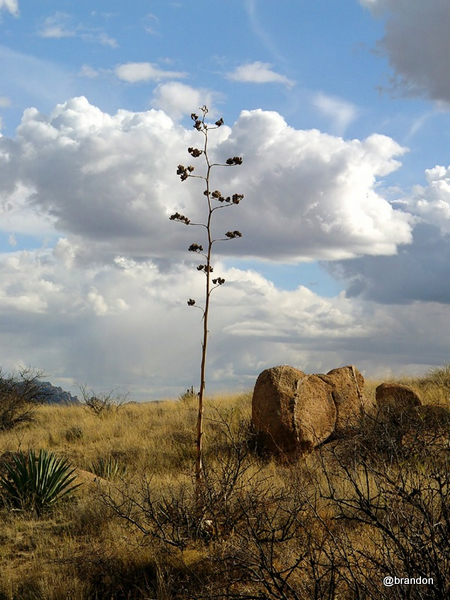
Scripture tells us that all true knowledge comes from God. Therefore, establishing an educational philosophy that uses this platform as a base for homeschool planning and instruction is prudent. Just as love comes from God, all true knowledge comes from Him. Discovering how to access this knowledge and being able to determine how to distinguish it from error is vital. Our heavenly Father is a loving parent who desires all of our hearts and who provides access to His glory through His Son. We learn of Him and of all He exemplifies by several means. By daily communion with Him through meditation and prayer He speaks to our hearts and, if we listen, we will hear His voice. As we participate in daily study of His perfect standard of truth, the Holy Scriptures, He reveals truths that the Holy Spirit helps us to understand. The mystery of godliness is made clear and His wisdom is expressed through His word. He also shares true knowledge with us through the things He has created. Through the revelation of the works He has made, we learn of His love. The perfect things of nature are a reflection of His character and teach us truths about our existence and of life. Nature’s object lessons and expressions of beauty are an application of the true knowledge that we read about in His word. Knowing the ways that God shares true knowledge with us, through communion with Him, the study of Scripture, and nature observation, we can establish a foundation for a homeschool course of study that uses these tools as a foundation for the intellectual growth and development of the whole child. All true knowledge is revealed through Him. All we need to do is to tap into it.
Tuesday, March 1, 2011
Creativity & Learning
“Creative activity could be described as a type of learning process where the teacher and pupil are located in the same individual.”
Arthur Koestler
Subscribe to:
Posts (Atom)


